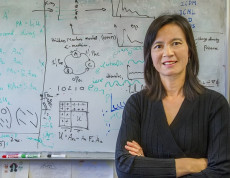Lab Staff to Ply Expertise at SIAM Conference on Applied Linear Algebra
October 21, 2015
by Jon Bashor

Xiaoye Sherry Li of CRD's Scalable Solvers Group will give an invited talk at the 2015 SIAM Conference on Applied Linear Algebra.
Xiaoye “Sherry” Li of CRD’s Scalable Solvers Group (SSG) will give an invited talk atthe SIAM Conference on Applied Linear Algebra taking place October 26-30 in Atlanta. Li, one of 12 plenary speakers, will discuss “Accelerating Direct Linear Solvers with Hardware and Algorithmic Advances” on Tuesday, October 27.
The conference is held every three years and is the leading meeting for researchers in the linear solvers community. Other Berkeley Lab contributions to the program include:
Li is a co-organizer of the mini-symposium sessions on Fast Solvers in Numerical Linear Algebra - Part Is and II.She is also a co-author on the paper “A Sparse Direct Solver for Distributed Memory GPU and Xeon Phi Accelerated Systems.”
Aydın Buluç and Ariful Azad of CRD’s Performance and Algorithms Research Group are co-authors ofthe paper “Generalized Sparse Matrix-Matrix Multiplication and Its Use in Parallel Graph Algorithms.”
Chao Yang of CRD’s SSG is co-organizer of the mini-symposium sessions New Numerical Linear Algebra Methods Meet New Challenges of Physics - Parts I and II. Yang is also author of a poster on “Linear Response and the Estimation of Absorption Spectrum in Time-Dependent Density Functional Theory.” He is also a co-author of the paper “A Structure-preserving Lanczos Algorithm for the Complex J-symmetric Eigenproblem.”
Lin Lin of SSG is author of the paper “Randomized Estimation of Spectral Densities of Large Matrices Made Accurate.”
Pieter Ghysels of CRD’s Performance and Algorithms Research Group and Li are among co-authors on the paper “A Comparison of Different Low-Rank Approximation Techniques.”
Francois-Henry Rouet of SSG and Li are co-authors on the paper “Comparison of FMM and HSS at Large Scale.”
Ghysels, Li and Rouet are co-authors of the papers “A Parallel Multifrontal Solver and Preconditioner Using Hierarchically Semiseparable Structured Matrices” and “A Parallel Multifrontal Solver and Preconditioner Using Hierarchically Semiseparable Structured Matrices.”
Meiyue Shao and Eugene Vecharynski of SSG are organizers of the mini-symposium sessionsLarge-Scale Eigenvalue Computations – Parts I and II
Vecharynski is author of the paper “Preconditioned Locally Harmonic Residual Methods for Interior Eigenvalue Computations”and a co-author of the paper “Preconditioned Solvers for Nonlinear Hermitian Eigenproblems with Variational Characterization.”
Shao, Yang and Jack Deslippe of NERSC are among the co-authors of the paper“Structure Preserving Algorithms for Solving the Bethe--Salpeter Eigenvalue Problem.”
Jim Demmel, a faculty scientist in SSG, is co-author of the papers “The s-Step Lanczos Method and its Behavior in Finite Precision” and “Sparse Approximate Inverse Preconditioners for Communication-Avoiding Bicgstab Solvers.”
Esmond G. Ng, head of CRD’s Applied Mathematics Department, is author of the paper “Large-Scale Eigenvalue Calculations in Scientific Problems.”
About Berkeley Lab
Founded in 1931 on the belief that the biggest scientific challenges are best addressed by teams, Lawrence Berkeley National Laboratory and its scientists have been recognized with 16 Nobel Prizes. Today, Berkeley Lab researchers develop sustainable energy and environmental solutions, create useful new materials, advance the frontiers of computing, and probe the mysteries of life, matter, and the universe. Scientists from around the world rely on the Lab’s facilities for their own discovery science. Berkeley Lab is a multiprogram national laboratory, managed by the University of California for the U.S. Department of Energy’s Office of Science.
DOE’s Office of Science is the single largest supporter of basic research in the physical sciences in the United States, and is working to address some of the most pressing challenges of our time. For more information, please visit energy.gov/science.









